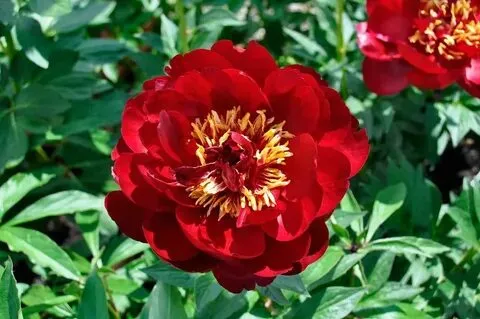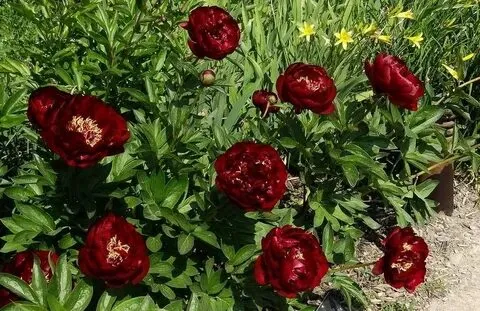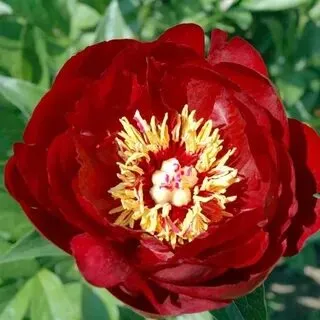How to Grow and Care for Buckeye Belle Peony
Overview of Buckeye Belle Peony
The Buckeye Belle peony, known for its striking deep red flowers and lush green foliage, is a favorite among gardeners. This perennial plant not only adds a touch of elegance to gardens but also requires minimal care, making it perfect for both novice and experienced gardeners. In this comprehensive guide, we will explore the Buckeye Belle peony in detail, from its origins and characteristics to its care requirements and propagation techniques.
Understanding Buckeye Belle Peony

Origin and Natural Habitat
The Buckeye Belle peony is a hybrid variety, resulting from the careful breeding of herbaceous peonies. Herbaceous peonies are native to temperate regions of Europe and Asia, thriving in areas with cold winters and warm summers. The Buckeye Belle peony was specifically developed to enhance the aesthetic appeal and resilience of peonies, combining the best traits of its parent plants.
Buckeye Belle Peony Care

Light Requirements
The Buckeye Belle peony thrives in full sun to partial shade. Ideally, it should receive at least six hours of direct sunlight each day to promote healthy growth and abundant flowering. In regions with intense summer heat, providing some afternoon shade can help protect the plant from scorching.
Best Soil Mix
Peonies prefer well-drained, fertile soil with a neutral to slightly acidic pH. Before planting, amend the soil with organic matter such as compost to improve its structure and nutrient content. Good drainage is essential, as peonies are prone to root rot in waterlogged conditions. Raised beds or mounds can be beneficial in areas with heavy clay soils.
Water Requirements
While peonies are relatively drought-tolerant once established, they perform best with regular watering. During the growing season, provide about one inch of water per week, either through rainfall or supplemental irrigation. Water deeply to encourage deep root growth, but avoid wetting the foliage to prevent fungal diseases.
Temperature and Humidity
Buckeye Belle peonies are hardy in USDA zones 3-8, able to withstand cold winters and hot summers. They require winter dormancy with temperatures below freezing to bloom profusely in spring. Humidity is generally not an issue for peonies, but good air circulation around the plants helps prevent fungal diseases.
Fertilizer
Peonies benefit from an annual application of balanced fertilizer in early spring, just as new growth begins to emerge. Use a fertilizer with equal parts nitrogen, phosphorus, and potassium (e.g., 10-10-10). Avoid over-fertilizing, as excessive nutrients can lead to lush foliage at the expense of flowers. Organic fertilizers like compost or well-rotted manure are also excellent options.
Pruning
Pruning is an essential part of peony care, helping to maintain plant health and promote vigorous growth. In late fall, after the first frost, cut back the foliage to the ground. This helps prevent the spread of diseases and pests that can overwinter in the debris. During the growing season, remove spent flowers to encourage more blooms and tidy the plant’s appearance.
Types of Buckeye Belle Peony

The Buckeye Belle peony is itself a unique variety, but it belongs to the larger family of herbaceous peonies, which includes many other stunning types. Some related varieties include the Sarah Bernhardt, Karl Rosenfield, and Festiva Maxima, each with its distinctive flower color and form. These varieties share similar growing requirements and can be planted together for a diverse and colorful peony garden.
Grow and Care for Belgravia Peony
Propagating Buckeye Belle Peony

Why Division?
While some peonies can be grown from seed, it’s a much slower process with unpredictable results. The division allows you to create genetically identical peonies to the parent plant, ensuring those gorgeous Buckeye Belle blooms.
Best Time for Division
Fall is the ideal time for dividing peonies. The cooler temperatures and increased moisture help the divisions establish themselves before winter. Aim for late September to October in most climates.
Dividing Your Buckeye Belle
- Dig it Up: Carefully dig around the base of your Buckeye Belle peony, giving yourself enough space to lift the entire plant.
- Sharpen Up: Use sharp, sterilized tools like a shovel or pruner to minimize damage.
- Divide and Conquer: Gently separate the plant into sections, each with at least 3-5 healthy eyes (buds) on the crown.
- Prep the Divisions: Remove any damaged roots and cut back the stems to about 4 inches.
- Planting the New Peonies: Choose a location with well-drained soil that receives at least 6 hours of sunlight daily. Dig planting holes large enough to accommodate the roots comfortably. Plant the divisions with the eyes facing upwards at a depth of 1-2 inches below the soil surface.
- Water Wisely: Water the newly planted peonies thoroughly and keep the soil moist but not soggy throughout the fall.
Potting and Repotting
While peonies are traditionally grown in the ground, they can also be successfully cultivated in large containers. Choose a pot that is at least 18 inches in diameter and depth to accommodate the plant’s extensive root system. Use a high-quality potting mix with good drainage, and ensure the container has drainage holes. Repotting is generally needed every 2-3 years to refresh the soil and manage root growth.
Common Pests & Plant Diseases
Peonies are relatively pest-resistant, but they can occasionally be affected by common garden pests such as aphids, thrips, and ants. Regular monitoring and natural predators like ladybugs can help control these pests. Fungal diseases, including botrytis blight and powdery mildew, are more prevalent. Ensure good air circulation, avoid overhead watering, and apply fungicides if necessary to manage these issues.
Troubleshooting Common Problems

Yellowing Leaves
Yellowing leaves can indicate overwatering, poor drainage, or nutrient deficiencies. Adjust watering practices and check soil health.
Poor Blooms
Poor blooming may result from insufficient sunlight, improper planting depth, or nutrient deficiencies. Ensure the plant is in a sunny location and fertilize appropriately.
Wilting
Wilting can be caused by underwatering, overwatering, or root damage. Check soil moisture levels and inspect roots for signs of rot or pests.
Winter Care for Buckeye Belle Peony

Preparing for Winter
Cut back peony stems to about 2 inches above the soil after the first hard frost. This helps prevent disease and prepares the plant for winter dormancy.
Mulching in Winter
Apply a layer of mulch around the base of the plant to protect the roots from extreme cold. Use straw, leaves, or pine needles.
Protecting from Frost
In areas with severe winters, cover the plant with burlap or a frost cloth for added protection.
Conclusion
The Buckeye Belle peony is a magnificent addition to any garden, offering striking beauty and relatively easy care. By understanding its origin, characteristics, and specific growing requirements, gardeners can enjoy a thriving peony display year after year. Whether planted in the ground or in a container, the Buckeye Belle peony promises to bring color and elegance to your outdoor space.
FAQs How to Grow and Care for Buckeye Belle Peony
How do I plant Buckeye Belle Peony bulbs?
Plant Buckeye Belle Peony bulbs in well-drained soil, 1-2 inches deep, and about 3-4 feet apart. Choose a sunny spot with at least 6 hours of sunlight daily for optimal blooming.
What is the best way to care for Buckeye Belle Peonies throughout the year?
Water Buckeye Belle Peonies regularly during dry spells but avoid waterlogging. Apply mulch in early spring to retain moisture and control weeds. Cut back dead foliage in late fall or early spring before new growth starts.
How can I prevent diseases in Buckeye Belle Peonies?
To prevent diseases, ensure good air circulation by spacing plants properly. Avoid overhead watering to reduce fungal issues, and remove any infected leaves promptly. Applying a fungicide in early spring can also help prevent common peony diseases.
